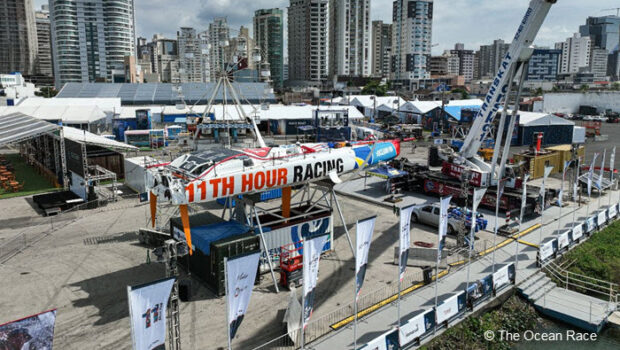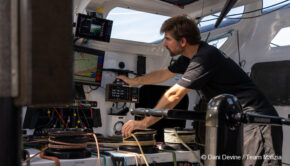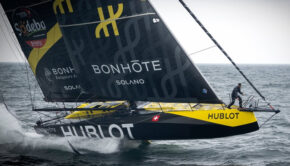Pit crews and The Ocean Race
Published on April 10th, 2023
Anyone who has followed the Volvo Ocean Race and the Whitbread before it, knows that winning ‘the unofficial world championship of fully-crewed offshore ocean racing’ requires a massive team effort both on the boats and on shore. With multiple stages and significant boat work needed at each port, effectively moving people and parts is a vital piece of the equation.
And it is this which makes The Ocean Race a new world for IMOCA teams, as their races are typically point-to-point and then return to base, or start and finish at the same port. The shore teams rarely work under acute time pressure with a race start – or re-start – just a few days away, when their boat needs to be in tip-top condition.
It is in this area where two worlds – the French school of solo and double-handed racing, and the more Anglo-Saxon tradition of the fully-crewed discipline with mid-race stopovers – are coming together. And someone who is seeing this at close quarters is The Ocean Race’s technical director Neil “Coxy” Cox – a straight-talking 54-year-old Sydneysider who has been running shore teams or race operations with the event for more than 20 years.
Cox says the five IMOCA teams are all making the leap, but some are better resourced than others when it comes to all-important shore team support.
“You can see them all stepping into this, and it isn’t the traditional way they normally do things,” he said from the dockside at Itajaí in Brazil, where all the teams are working on their boats ahead of the start of Leg 4 on April 23. “Some have stepped up to it really, really well while others are, not resistant to it, but it’s more a case of whether they have the resources to do it.”
Representing the race organization, Cox – who previously ran the full-fleet servicing Boatyard during the one-design VO65 era – sees his role in this edition as a facilitator. Using all his experience and contacts, he ensures that each team has everything it needs to enable it to hit the ground running at each stopover.
This includes basics like dockside land space, power, water, and internet, to local contacts with companies supplying craning, forklifts and air freight. At Itajaí, Cox also oversaw the preparation of a berthing marina for the fleet, which involved a dredging operation.
“We get every facility in place for these guys to show up with their own assets,” he said. “It’s like trying to make sure they almost feel like they are arriving in Lorient every time they hit the ground, other than the fact that each location is culturally vastly different.”
Cox knows better than anyone that getting the shore team element right in this race is critical to success.
“It’s a total team effort to get through the whole race,” he explained. “To me it is the hardest yacht race in the world to win and the easiest to lose. Because at any level, or any layer, within the machine, something small can propagate into something that just costs points. And that can be on the boat offshore, or how things are managed onshore – in every race it is always an incredibly well-balanced team that is a strong performing team.”
After the 14,000-mile marathon from Cape Town, this stopover is fundamental to each team’s fortunes in this race. Cox says the condition that the boats leave Brazil, as they set sail for Newport, will go a long way to determining the eventual outcome.
“How you leave here is truly how you set yourself up for the rest of the race, with Newport a non-haul-out stopover, and then you end up in Aarhus and the sprint through Europe. The core condition of your boat, as to how it leaves here, plays a huge role in how you go for the rest of the race,” he said.
To put the shore team workload in Itajai into perspective, Cox points out that with the Volvo 70s and VO65 fleets, the boats would get a full service after every 10,000 miles. “These boats have just done 14,000 miles in one leg, so pretty much everything needs to be serviced,” he notes.
Having working on the 70s and the 65s, Cox has been impressed by both the IMOCA sailing crews and the boats, which he says have turned up in Brazil without what he calls “show-stopping” maintenance issues, and in better shape than previous fleets that had arrived in South America after sailing less than half the race distance of Leg 3.
“I think the condition of the fleet here is a testament to the boats themselves, the design of the boats, the way they are maintained and the people sailing them,” he said. “Right now there is probably more re-hab and re-build required of some of the sailors than the boats. That’s what we keep not talking about – there are some pretty exhausted humans that have brought these boats 14,000 miles to here.”
Cox has no doubt that the skippers and sailors involved in this race will already have learnt how to sail their foilers at a level that they could not have reached as single-handers. He reckons the knowledge gained will be to their advantage in future short-handed races, but the lessons learned will also percolate through the Class.
“You can see the performance curve increase in terms of what these boats are like single-handed compared to crewed, and the skippers have witnessed that, so anyone external to this would have to be paying attention,” he said. “There are definitely learnings for these guys which only they have now…but I think the greatest sharing of information will probably come from those here that have done it.”
Cox believes that understanding the shore team culture of this event, is all part of the way that IMOCA is broadening its reach and expertise as a class and he is all for it. He says the roots of this merging of the French and Anglo-Saxon offshore worlds goes back some years.
“Everyone was off in their own world and we never really had the opportunity to blend, but the fact that we had canting keels on Volvo 70s, shows we were already looking over the fence at what was happening in France, where they were coming up with these fantastic ideas for performance offshore boats.
“So there has always been that connection and respect for what was going on there. Now it is starting to mesh a bit and the reality is that the more we can start to get a bit more internationalization of the fleet, the more that will benefit everyone, especially from a commercial point of view.”
Boat-wise in this event, Cox has seen it all, and reckons the IMOCA 60s are the coolest fleet yet to take on this historic challenge. “The Volvo 70 were incredible machines and IMOCA are now even better. Obviously these boats are pretty labor-intensive both to sail and maintain – there’s a reason why, and that’s all about performance.”
Overall Leaderboard (after 3 of 7 legs)
1. Team Holcim-PRB — 19 points
2. Team Malizia — 14 points
3. 11th Hour Racing Team — 13 points
4. Biotherm — 10 points
5. GUYOT environnement – Team Europe — 2 points
Race details – Route – Tracker – Teams – Content from the boats – YouTube
IMOCA: Boat, Design, Skipper, Launch date
• Guyot Environnement – Team Europe (VPLP Verdier); Benjamin Dutreux (FRA)/Robert Stanjek (GER); September 1, 2015
• 11th Hour Racing Team (Guillaume Verdier); Charlie Enright (USA); August 24, 2021
• Holcim-PRB (Guillaume Verdier); Kevin Escoffier (FRA); May 8, 2022
• Team Malizia (VPLP); Boris Herrmann (GER); July 19, 2022
• Biotherm (Guillaume Verdier); Paul Meilhat (FRA); August 31 2022
The Ocean Race 2022-23 Race Schedule:
Alicante, Spain – Leg 1 (1900 nm) start: January 15, 2023
Cabo Verde – ETA: January 22; Leg 2 (4600 nm) start: January 25
Cape Town, South Africa – ETA: February 9; Leg 3 (12750 nm) start: February 26
Itajaí, Brazil – ETA: April 1; Leg 4 (5500 nm) start: April 23
Newport, RI, USA – ETA: May 10; Leg 5 (3500 nm) start: May 21
Aarhus, Denmark – ETA: May 30; Leg 6 (800 nm) start: June 8
Kiel, Germany (Fly-By) – June 9
The Hague, The Netherlands – ETA: June 11; Leg 7 (2200 nm) start: June 15
Genova, Italy – The Grand Finale – ETA: June 25, 2023; Final In-Port Race: July 1, 2023
The Ocean Race (formerly Volvo Ocean Race and Whitbread Round the World Race) was initially to be raced in two classes of boats: the high-performance, foiling, IMOCA 60 class and the one-design VO65 class which has been used for the last two editions of the race.
However, only the IMOCAs will be racing round the world while the VO65s will race in The Ocean Race VO65 Sprint which competes in Legs 1, 6, and 7 of The Ocean Race course.
Additionally, The Ocean Race also features the In-Port Series with races at seven of the course’s stopover cities around the world which allow local fans to get up close and personal to the teams as they battle it out around a short inshore course.
Although in-port races do not count towards a team’s overall points score, they do play an important part in the overall rankings as the In-Port Race Series standings are used to break any points ties that occur during the race around the world.
The 14th edition of The Ocean Race was originally planned for 2021-22 but was postponed one year due to the pandemic, with the first leg starting on January 15, 2023.
Source: Ed Gorman, IMOCA









 We’ll keep your information safe.
We’ll keep your information safe.